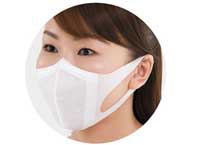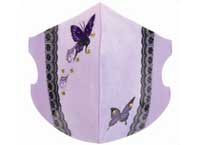Web Japan > Trends in Japan > Lifestyle > Masked Masses
Masked Masses
Masks Used to Keep Out Germs and Pollen
The arrival of winter - and with it, the flu season - is marked in Japan by a conspicuous number of individuals donning surgical masks when out and about. Their numbers swell even further as temperatures rise at the start of spring, when increased pollen has hay fever sufferers reaching for their masks. Masks have a variety of benefits: They help prevent colds and flu from spreading between individuals, and they also keep out airborne pollen. While many masks remain simple affairs of layered gauze, newer, hi-tech types are appearing, some of which are even capable of neutralizing viruses.
Masking Up at School and in the Workplace
To prevent the spread of influenza when the virus is circulating, sometimes classes or even entire schools suspend lessons, since coughing and sneezing scatter the flu virus throughout the air in classrooms. Of course, it is good manners to cover one's mouth or nose when coughing or sneezing, but this alone is not enough to prevent the spread of viral infections; masks are much more effective.
Viruses thrive in dry environments, so a further advantage of masks is that they keep moisture in, preventing the body's protective mucous membranes from drying out and, thus, stopping germs from spreading. Since masks help protect both the wearer and surrounding individuals, wearing a mask in flu season is increasingly seen as good manners, and more and more mask wearers can be seen on trains and in the workplace, streets, and shops.
Advanced Masks That Neutralize Viruses
Improving the functionality of masks is vital for improving their effectiveness. Old-style gauze masks are of limited effectiveness against microscopic viruses, which can pass through the holes between fibers. Newer, more effective masks made from fine, nonwoven materials are becoming the norm. And the newest models to hit the market incorporate the latest technology. For example, some masks now on sale are capable of blocking over 99% of particles measuring just 0.1 microns across, while others do not simply block germs but use negative ions, photocatalysts, or activated carbon to neutralize any virus particles they meet.
Manufacturers are also striving to make masks easier to use. Masks can now be divided into two broad styles: those that come folded flat with pleats (like the ones commonly used by hospital staff) and those that pop out into three dimensional shapes, similar to a bird's beak. Mask makers have succeeded in creating closer-fitting masks that allow the wearer to talk and breathe without difficulty and masks that do not cause eyeglasses to fog up, among other improvements.
Design is another area of innovation. Until now surgical masks have all tended to be the same color: white. But now pink masks, masks with heart-shaped stickers, and even masks decorated with rhinestones have begun to appear. What was until recently a purely functional item is beginning to be seen as a fashion accessory.
Hay Fever Filters
For a large number of people in Japan, springtime brings the onset of hay fever symptoms caused by pollen from cedar trees and other vegetation. The symptoms of hay fever, which include itchy eyes and a runny nose, can be severe and last throughout the season (roughly February to April). Help is at hand, however. Since pollen particles are many times larger than viruses that get released into the air with coughing and sneezing, individuals can double up their defenses by wearing one of the newer-style masks. Even old-style masks can be an effective means of guarding against hay fever, especially if a special spray is applied to enhance their pollen-blocking capability.
Japan's masked legions may strike foreign visitors as odd at first, but masks have become an integral part of the fight against airborne infections and hay fever. They have become so common that many Japanese would not think of leaving home in winter and early spring without their trusty mask. (March 2009)



